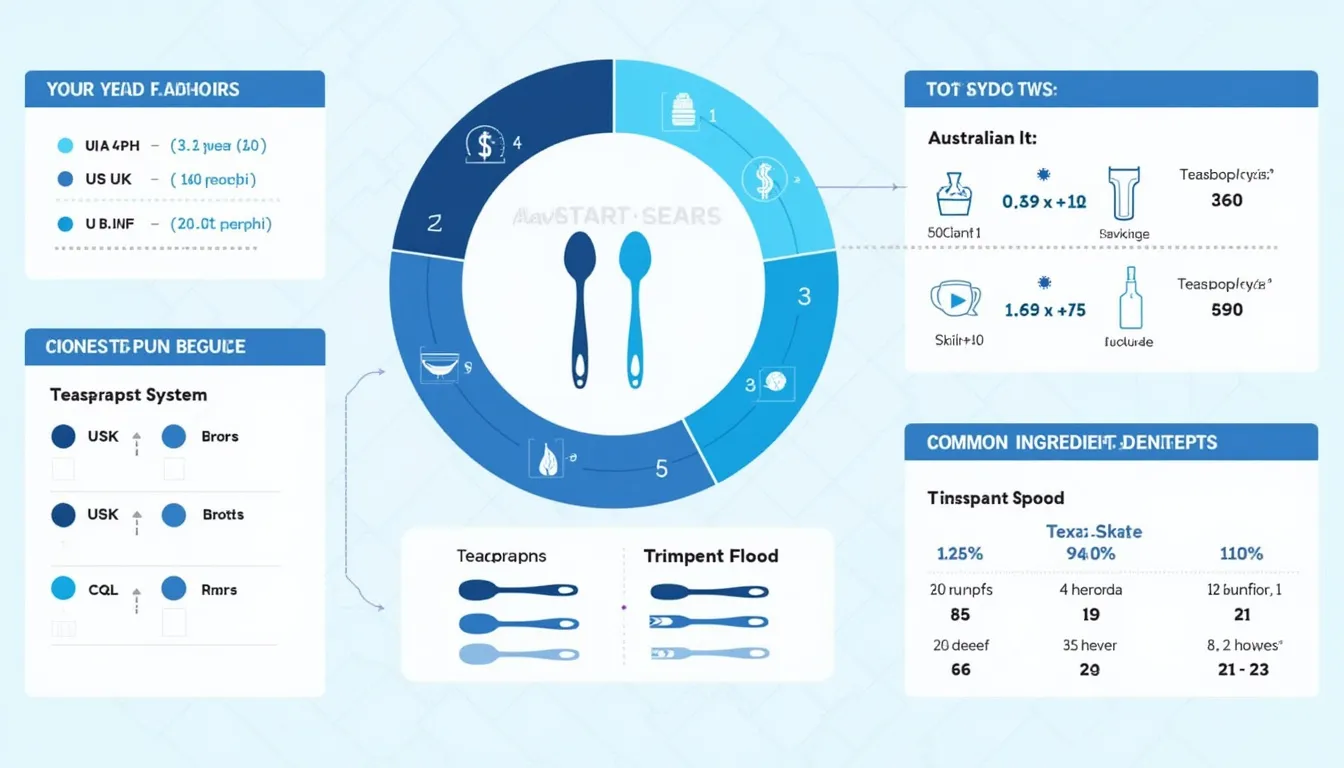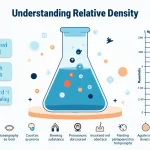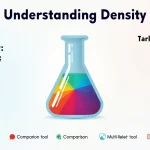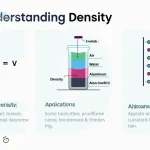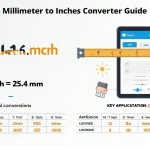Is this tool helpful?
How to Use the Teaspoons to Tablespoons Converter Effectively
Our Teaspoons to Tablespoons Converter is a versatile tool designed to simplify kitchen measurements and recipe conversions. Here’s a step-by-step guide on how to use this calculator effectively:
1. Select the Measurement System
Begin by choosing the appropriate measurement system from the dropdown menu:
- US Customary: Used in the United States
- UK Imperial: Used in the United Kingdom
- Australian Metric: Used in Australia
For example, if you’re following a recipe from an American cookbook, select “US Customary.”
2. Enter the Input Value
In the “Input Value” field, type the number of teaspoons or tablespoons you want to convert. Use only positive numbers and decimals if needed. For instance, enter “4.5” if you want to convert 4 and a half teaspoons.
3. Choose the Conversion Direction
Select whether you want to convert from teaspoons to tablespoons or vice versa using the “Convert From” dropdown menu:
- Teaspoons to Tablespoons: Use this option when you have a teaspoon measurement and need the equivalent in tablespoons.
- Tablespoons to Teaspoons: Choose this when you want to convert tablespoons to teaspoons.
4. Select a Product (Optional)
If you want to know the mass of the ingredient you’re measuring, select a product from the dropdown menu. Options include:
- Water
- Granulated Sugar
- All-Purpose Flour
- Salt
- Olive Oil
- Honey
- Milk
For example, if you’re measuring honey, select “Honey” from the list.
5. Click “Convert”
After entering all the necessary information, click the “Convert” button to get your results.
6. Read the Results
The converter will display the converted measurement and, if a product was selected, the equivalent mass in grams.
Understanding Teaspoons and Tablespoons: An Introduction
Teaspoons and tablespoons are common volume measurements used in cooking and baking. However, their exact definitions can vary depending on the measurement system used. Our Teaspoons to Tablespoons Converter is designed to bridge these differences and provide accurate conversions across various systems.
Definition and Purpose
This converter serves multiple purposes:
- Converting between teaspoons and tablespoons in different measurement systems
- Providing equivalent mass measurements for common kitchen ingredients
- Simplifying recipe adjustments and scaling
By offering these functionalities, the tool aims to make cooking and baking more precise and accessible, regardless of the recipe’s origin or the user’s preferred measurement system.
Benefits of Using the Converter
Utilizing this teaspoon to tablespoon converter offers several advantages:
- Accuracy: Ensures precise conversions between teaspoons and tablespoons across different measurement systems.
- Time-saving: Eliminates the need for manual calculations or searching for conversion charts.
- Versatility: Accommodates US, UK, and Australian measurement systems in one tool.
- Mass conversion: Provides equivalent mass measurements for common ingredients, useful for precise baking.
- Recipe scaling: Facilitates easy adjustment of recipe quantities.
- Error reduction: Minimizes the risk of measurement errors in cooking and baking.
The Science Behind Teaspoon to Tablespoon Conversions
Understanding the mathematical relationships between teaspoons and tablespoons is crucial for accurate conversions. Let’s explore the formulas and constants used in our converter:
Conversion Factors
The relationship between teaspoons and tablespoons varies depending on the measurement system:
$$
\begin{align*}
\text{US Customary:} & \quad 1 \text{ tablespoon} = 3 \text{ teaspoons} \\
\text{UK Imperial:} & \quad 1 \text{ tablespoon} = 3 \text{ teaspoons} \\
\text{Australian Metric:} & \quad 1 \text{ tablespoon} = 4 \text{ teaspoons}
\end{align*}
$$
Volume in Milliliters
Each system defines teaspoons and tablespoons differently in terms of milliliters:
$$
\begin{align*}
\text{US Customary:} & \quad 1 \text{ teaspoon} = 4.92892 \text{ mL}, \quad 1 \text{ tablespoon} = 14.7868 \text{ mL} \\
\text{UK Imperial:} & \quad 1 \text{ teaspoon} = 5.91939 \text{ mL}, \quad 1 \text{ tablespoon} = 17.7582 \text{ mL} \\
\text{Australian Metric:} & \quad 1 \text{ teaspoon} = 5 \text{ mL}, \quad 1 \text{ tablespoon} = 20 \text{ mL}
\end{align*}
$$
Conversion Formulas
To convert between teaspoons and tablespoons, we use the following formulas:
$$
\begin{align*}
\text{Tablespoons to Teaspoons:} & \quad \text{Teaspoons} = \text{Tablespoons} \times \text{Conversion Factor} \\
\text{Teaspoons to Tablespoons:} & \quad \text{Tablespoons} = \frac{\text{Teaspoons}}{\text{Conversion Factor}}
\end{align*}
$$
Mass Conversion
To calculate the mass of an ingredient, we use the density and volume:
$$
\text{Mass (g)} = \text{Density (g/mL)} \times \text{Volume (mL)}
$$
Practical Applications of the Teaspoon to Tablespoon Converter
Our converter addresses various user needs and solves specific problems in cooking and baking. Let’s explore some practical applications:
1. Recipe Scaling
When adjusting recipe quantities, precise conversions are crucial. For example, let’s scale up a recipe that calls for 2 teaspoons of vanilla extract to serve more people:
Using US Customary measurements:
- Original recipe: 2 teaspoons
- Scaled recipe (1.5x): 3 teaspoons
- Converted to tablespoons: 1 tablespoon
Our converter simplifies this process, providing accurate results instantly.
2. International Recipe Adaptation
When following recipes from different countries, measurement conversions can be tricky. Let’s convert a UK recipe measurement to US:
Converting 4 UK tablespoons of olive oil to US tablespoons:
- 4 UK tablespoons = 71.0328 mL
- US tablespoons = 71.0328 mL ÷ 14.7868 mL/tbsp ≈ 4.8 US tablespoons
Our converter handles these complex calculations, ensuring accurate recipe adaptations.
3. Precise Ingredient Measurements
For baking, where precision is crucial, knowing the mass of ingredients can be helpful. Let’s calculate the mass of sugar in a recipe:
Calculating the mass of 2 US tablespoons of granulated sugar:
- Volume: 2 × 14.7868 mL = 29.5736 mL
- Density of sugar: 0.85 g/mL
- Mass: 29.5736 mL × 0.85 g/mL ≈ 25.14 g
Our converter provides this information instantly, improving baking precision.
4. Kitchen Tool Substitution
When you’re missing a specific measuring spoon, our converter can help. For instance, if you need 1 tablespoon but only have teaspoons:
Using US Customary measurements:
- 1 tablespoon = 3 teaspoons
This quick conversion allows you to measure accurately with the tools you have on hand.
5. Nutritional Information Calculation
When tracking nutritional intake, converting volume to mass is essential. Let’s calculate the calories in a tablespoon of honey:
Using US Customary measurements:
- 1 US tablespoon of honey = 14.7868 mL
- Density of honey: 1.42 g/mL
- Mass: 14.7868 mL × 1.42 g/mL ≈ 21 g
- Calories: 21 g × 3.04 cal/g ≈ 64 calories
Our converter provides the mass, simplifying nutritional calculations.
Exploring Different Measurement Systems
Understanding the differences between measurement systems is crucial for accurate conversions. Let’s delve deeper into each system our converter supports:
US Customary System
The US Customary system is used primarily in the United States and defines measurements as follows:
- 1 US tablespoon = 3 US teaspoons
- 1 US tablespoon = 14.7868 mL
- 1 US teaspoon = 4.92892 mL
This system is commonly used in American recipes and cookbooks.
UK Imperial System
The UK Imperial system, used in the United Kingdom, has slightly different definitions:
- 1 UK tablespoon = 3 UK teaspoons
- 1 UK tablespoon = 17.7582 mL
- 1 UK teaspoon = 5.91939 mL
These measurements are typically found in British recipes and cookbooks.
Australian Metric System
The Australian Metric system uses a different relationship between tablespoons and teaspoons:
- 1 Australian tablespoon = 4 Australian teaspoons
- 1 Australian tablespoon = 20 mL
- 1 Australian teaspoon = 5 mL
This system is used in Australian recipes and aligns more closely with the metric system.
Advanced Features: Mass Conversion for Common Ingredients
Our converter goes beyond simple volume conversions by offering mass calculations for common kitchen ingredients. This feature is particularly useful for precise baking and nutritional calculations.
Density of Common Ingredients
The converter uses the following densities for mass calculations:
- Water: 1.00 g/mL
- Granulated Sugar: 0.85 g/mL
- All-Purpose Flour: 0.53 g/mL
- Salt: 1.20 g/mL
- Olive Oil: 0.91 g/mL
- Honey: 1.42 g/mL
- Milk: 1.03 g/mL
Mass Calculation Example
Let’s calculate the mass of 2 Australian tablespoons of all-purpose flour:
- Convert to volume: 2 × 20 mL = 40 mL
- Apply density: 40 mL × 0.53 g/mL = 21.2 g
Our converter performs these calculations instantly, providing both volume and mass information.
Frequently Asked Questions (FAQ)
Q1: Why do I need to specify the measurement system?
A1: Different countries use slightly different definitions for teaspoons and tablespoons. Specifying the measurement system ensures accurate conversions based on the correct definitions.
Q2: Can I use this converter for liquid and dry ingredients?
A2: Yes, the converter works for both liquid and dry ingredients. For mass calculations, select the specific ingredient from the dropdown menu for the most accurate results.
Q3: How does the mass calculation feature work?
A3: When you select a specific ingredient, the converter uses its density to calculate the mass based on the volume. This provides a more precise measurement, especially useful for baking.
Q4: Why are Australian tablespoons different from US and UK tablespoons?
A4: Australia adopted a metric tablespoon of 20 mL, which is larger than the US and UK tablespoons. This results in the unique 4:1 ratio between tablespoons and teaspoons in the Australian system.
Q5: Can I use this converter for medications?
A5: While the converter is accurate for cooking measurements, it’s not recommended for medication dosing. Always use proper medical measuring tools and follow healthcare professional advice for medications.
Q6: How do I convert between different measurement systems?
A6: To convert between systems, first convert to the base unit (mL) using the original system, then convert from mL to the desired system. Our converter handles this process automatically when you change the measurement system.
Q7: Are the mass calculations exact?
A7: The mass calculations are based on average densities of ingredients. While they provide a good estimate, slight variations can occur due to factors like ingredient brand, temperature, and humidity.
Q8: Can I use the converter for recipe scaling?
A8: Absolutely! The converter is an excellent tool for scaling recipes. Simply input the original measurement and use the converted result to adjust your recipe proportions.
Q9: Why doesn’t the converter include cups or other measurements?
A9: This converter focuses specifically on the relationship between teaspoons and tablespoons. For other conversions, you may need to use additional tools or converters.
Q10: How often should I use this converter when cooking?
A10: The frequency of use depends on your cooking habits and the recipes you follow. It’s particularly useful when working with international recipes, scaling quantities, or when precision is crucial, such as in baking.
Conclusion: Mastering Kitchen Measurements with the Teaspoon to Tablespoon Converter
Our Teaspoon to Tablespoon Converter is an indispensable tool for both novice cooks and seasoned chefs. By providing accurate conversions across different measurement systems and offering mass calculations for common ingredients, it simplifies recipe interpretation, scaling, and international cooking.
Remember, precise measurements can make a significant difference in your culinary creations, especially in baking. Whether you’re adapting a family recipe, exploring international cuisines, or simply ensuring consistency in your cooking, this converter is your reliable kitchen companion.
Embrace the ease and accuracy of digital conversion while maintaining the joy and creativity of cooking. With this tool at your fingertips, you’re well-equipped to tackle any recipe, regardless of its origin or the measurement system it uses. Happy cooking and baking!
Important Disclaimer
The calculations, results, and content provided by our tools are not guaranteed to be accurate, complete, or reliable. Users are responsible for verifying and interpreting the results. Our content and tools may contain errors, biases, or inconsistencies. We reserve the right to save inputs and outputs from our tools for the purposes of error debugging, bias identification, and performance improvement. External companies providing AI models used in our tools may also save and process data in accordance with their own policies. By using our tools, you consent to this data collection and processing. We reserve the right to limit the usage of our tools based on current usability factors. By using our tools, you acknowledge that you have read, understood, and agreed to this disclaimer. You accept the inherent risks and limitations associated with the use of our tools and services.
